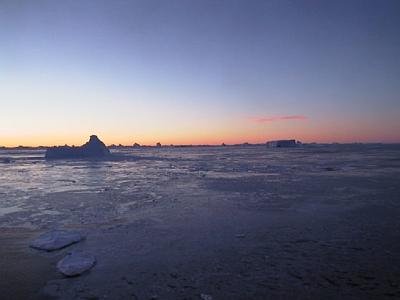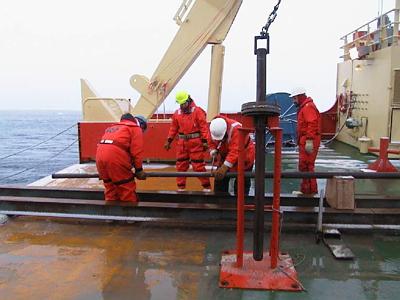
|
|
23 March, 2000
One Morning in Antarctica
71 03 s 102 20 w
Wind 20 knots (23 mph) out of S
Temp -14 C (7 F)
Barometer 1000 mb, steady
Course 002 @ 6 knots (7mph) going north to get east
Breaking a mix of old floes, new gray, and brash ice
I'm up in the ice tower several hours before dawn. We've taken the
last core of the trip, and although there is still a lot to do, things are
not quite as hectic as they were before.
Now that we are past the equinox, we have more than twelve hours of
darkness. The sun set about 6:30 last night and will rise after 7:00
tomorrow morning. Just a little over a month ago in McMurdo the sun, if we
had been able to see it, would have been above the horizon twenty-four
hours a day. Drew Logan, a computer guru (that's not his official title)
aboard the Nathaniel B. Palmer, wintered over several times at South Pole
station. He says there are two parcticular days there, sunset day and
sunrise day, when the sun circles the sky, cut in half by the horizon.
A waning moon, still more than half full, and Venus set into a
long thin line of dark orange stretching across the northern horizon.
Broken and jagged bergs jut above the horizon like black teeth. It's a cold
place, especially when I step out onto the catwalk surrounding the tower to
take a picture. I come back into the ice tower quickly, and stand over the
little electric heater. There are still open patches of black water in the
gray ice, and I wonder how they stay open, even with the wind the way it
is. In one of these patches, momentarily illuminated by the ship's
spotlights, a black seal head pops up, looks around and disappears.
Later the mate pops up through the ice tower hatchway. He wants to
get a better view to the north, where he sees the kind of sky he thinks
indicates open water. He points to the area, but it looks the same as any
other place to my inexperienced eyes.
Down on deck, I'm outside in the cold wind, and it seems a long
time since 11:00 PM when I climbed out of my warm bunk. We're chugging
along in storm-broken 3-4 m (10-13 ft) floes, with brash ice in between.
There are dozens of icebergs in view, mostly the older, worn and overturned
kind. If you want to imagine their shapes, find some old science fiction
paperbacks and look at the cover illustrations. The bergs have the same
bizarre shapes as the houses, cities and landscapes on those covers. The
Ross Sea bergs we saw earlier in the trip tended to be flat topped, sharp
edged, and unworn. Earlier a crewmember had told me he thought the Amundsen
Sea bergs were more interesting than those of the Ross Sea. Stan Jacobs has
done some thinking about the difference. He told me that the Ross Sea bergs
may be younger because the water is deeper and they don't tend to ground
there. Additionally, currents may be stronger in the Ross Sea, moving the
bergs offshore to melt before they get old.
Some floes have small snowdrifts, and many have evidence of life.
Seal belly tracks look like the little snail tracks you see in the bottom
of tide pools, only much larger. Some floes are covered with these grooves,
all tending to converge on one place where the seals gathered. Zipper-like
penguin tracks are more common. A zipper with a line down the middle
indicates the penguin was sliding along on its belly. If there is no line,
then the bird was walking. For a moment I consider the possibility of using
the penguin tracks to reassemble the broken floes to their original, larger
selves. It's neither a practical or useful idea, the product of too little
sleep. Occasionally we pass intensely blue ice pieces, which look like
turned over bits of old bergs.
Three Adelie penguins watch the ship pass, far enough away so that
they don't feel the need to flee. The diesels rumble below, the ice
screeches and rattles past the steel sides of the ship. I catch that
universal ship smell, the galley ventilator, savory in the cold air.
It's interesting to watch the ice as the ship moves. Most floes
seem to get pushed off to the side at right angles to the ship's motion,
often rotating as they go. Next to the ship, broken pieces of floes stand
on edge and occasionally tumble over, turning their snowy white tops down
and revealing their rotten yellowish-brown undersides. Occasionally, the
ship runs directly over floes. They squirt out from underneath the ship
half way back, tumbling over in slow motion, blue water cascading off their
edges. Run-over floes that make it all the way to the stern may get
involved with the ships 3m (10ft) props, shaking the whole ship, then
emerging somewhat battered from below the back deck. Even at slow speeds in
pack ice the ship has a bow wave, and everything rises up and over it. This
wave must somehow generate pressure under the ice; once in a while the
center of a floe will bulge and explode a fountain of water and ice.
No matter where we go in pack ice, night or day, fair weather or
foul, snow petrels accompany us. They are unmistakable, all white except
for obvious dark eyes and bill. They orbit the ship and sometimes dart
down to pick something out of the water. I never see them land on ship, ice
or water. According to George E. Watson's Birds of the Antarctic and
Sub-Antarctic, they eat mainly fish, cephalopods, and krill, but may also
dine on seal placentas and dead animals. The same book says that they
usually nest in cliff colonies near the coast, but colonies have been seen
as far as 325 km (200 mi.) inland. It doesn't say how they feed their young
200 miles from any food supply, but the petrels know.
After a while I can't take the cold on deck, so I go to the galley
and get a cup of fresh brewed coffee in a paper cup. I take this with me
back up to the ice tower. I carry it up five flights of stairs and three
ladders, and don't spill a drop!
The sun is now bright, and although low on the horizon,
illuminates everything in glaring white light. Behind the ship I see our
cleared trail through the hot breath of the diesel exhaust. Ahead to one
side is a large berg with water caves to explore, if you had time and a
Zodiac and dared. The ship occasionally backs and rams to get through thick
areas, and then comes to a stop near a large, flat floe. The bow crane
lowers the ice people. Two floes away a solitary Crabeater seal hauls out.
It rolls on its back, either to scratch or dry off, turns upright again,
and settles down for a nap. Just another day in the pack ice 'hood.

Predawn off Thurston Island.

Removing a core from the piston corer. The core itself is in a transparent plastic core liner tube. We slide it out until empty tube appears, then cut it for easier handling. The trigger core stands in its rack in the foreground, with the core still in it. We'll get to that next. From left to right: Dave Green, Alice Doyle, Dr. Terri Hughes, Jay Ardai.

A few moments later, the sun arrives. It doesn't warm things up much, and by ten in the morning it's gone, replaced by clouds and snow.
Contact the TEA in the field at
.
If you cannot connect through your browser, copy the
TEA's e-mail address in the "To:" line of
your favorite e-mail package.
|
